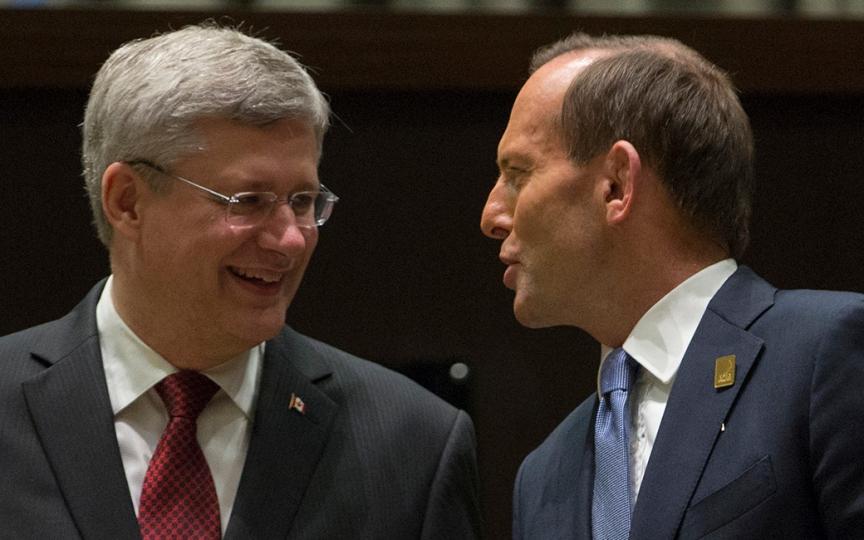 Tony Abbott’s early June visit to Ottawa, Washington, and New York and then to France for the 70th anniversary of the D-day landings, offers a platform for the Prime Minister to set directions in one essential relationship—the US—and two under-rated ones, France and Canada. Each leg of his visit deserves a blog post outlining the strategic opportunities and risks in those relationships. After the PM’s North Asia visit it’s clear the government wants to reshape Australia’s key international partnerships. In addition to the Free Trade Agreements, promoting closer strategic ties with Japan and more open investment relations with China shows the government aims for more than just continuity. In Canberra, where success in officialdom is measured more by delivering stability than change, that reshaping may come as a surprise.
Tony Abbott’s early June visit to Ottawa, Washington, and New York and then to France for the 70th anniversary of the D-day landings, offers a platform for the Prime Minister to set directions in one essential relationship—the US—and two under-rated ones, France and Canada. Each leg of his visit deserves a blog post outlining the strategic opportunities and risks in those relationships. After the PM’s North Asia visit it’s clear the government wants to reshape Australia’s key international partnerships. In addition to the Free Trade Agreements, promoting closer strategic ties with Japan and more open investment relations with China shows the government aims for more than just continuity. In Canberra, where success in officialdom is measured more by delivering stability than change, that reshaping may come as a surprise.
Tony Abbott’s meeting with fellow conservative Canadian PM Stephen Harper will inevitably be overshadowed by his later meeting with President Obama, but we shouldn’t underestimate Abbott’s interest in the Canadian relationship. In February this year he told the Australia-Canada Economic Leadership Dialogue in Melbourne that ‘the relationship is strong but under-developed even though we are as like-minded as any two countries can be. So, I want to make more of this friendship: for our own good and for the good of the wider world’. As Abbott’s speech makes clear, he values the link for its historical foundations in military cooperation during WWI. The PM was too savvy to use the term ‘Anglosphere’, because that would have been reviled by the usual glassy-eyed suspects, but it’s clear the government sees the intelligence relationship between the five-eyes countries as bedrock national security. The question is: what more could or should be done in defence and security cooperation between Canberra and Ottawa?
One thing Abbott and Harper desperately need to do is provide a more positive focus for bilateral cooperation than the one currently dominating discussions of officials and think-tankers. This increasingly negative dialogue focuses on Canada’s security engagement with Asian countries. At the 2013 Shangri La Dialogue, then Canadian Defence Minister Peter MacKay made a pitch for his country’s membership of the ASEAN Defence Ministers Plus grouping. The advance was politely rebuffed on the day by Singapore Defence Minister Ng En Hen. (I wrote about this here.) Since then, joining ADMM+ as well as the East Asia Summit has emerged as a key objective and Ottawa has expectations of Australian assistance to deliver that outcome.
Here we come to the problem: Canberra isn’t disposed to support Ottawa’s membership bids. The Australian perspective is that it has been difficult enough to assure our own membership as an intrinsic part of the region. We back the Singaporean view put by Minister Ng in 2012 that, at this stage, the priority should be put on the effectiveness of regional institutions rather than their inclusiveness. But that Australian perspective has been put with over-zealous bluntness to our Canadian colleagues and risks being misread as a sign we’ve lost interest in a close relationship with Ottawa.
The Canadian view has its own set of blinkers, which in their case goes to the amount of defence contact needed to sustain a credible level of Asia-Pacific engagement. Canadians don’t accept the point that the price of entry to regional security cooperation is a lot higher than token military involvement in multilateral meetings. The two countries have been circling around this buoy for 18 months with Canada growing frustrated at perceived Australian unhelpfulness, and Australia nonplussed about Canada’s expectation in relation to low-cost regional engagement. It’s time for some Prime Ministerial adult supervision to start a more practically-focussed conversation.
What should Tony Abbott put on the table as a start point for a new discussion with Stephen Harper to (as he said in Melbourne) ‘broaden and deepen the relationship between our two kindred countries’? In the defence and national security space I’d focus on bilateral cooperation and suggest four fruitful areas:
- Agree to review the existing framework of bilateral defence cooperation. A surprising amount is taking place, much of it the product of long standing Service-to-Service cooperation. Some modernisation would free savings and allow a re-focus on newer areas of defence activity.
- Agree to a mechanism for sharing the lessons of defence equipment procurement, and which looks for synergies in ship-building, combat vehicles and sustainment as three areas where early benefits of closer cooperation might be found.
- Find ways to make Defence frugality a virtue. The two Defence organisations are similar in scale and design. A more consciously-managed sharing of defence reform lessons could produce savings for both countries.
- Finally, agree to jointly identify some small scale Defence Cooperation Program activities that can be double-flagged in the Asia-Pacific.
To support those moves both governments will have to get serious about funding activities that bring the two militaries together, but the real commitments will be of time and intellectual energy. We’ll soon see if the two Prime Ministers want real progress or if they’re content with the warm memories of past battlefield experiences to sustain the relationship.
Peter Jennings is executive director of ASPI. Image courtesy of the Office of the Prime Minister of Canada.